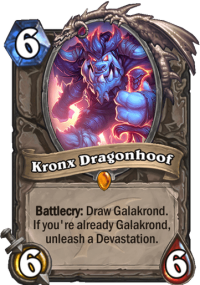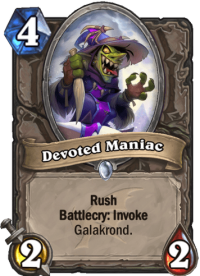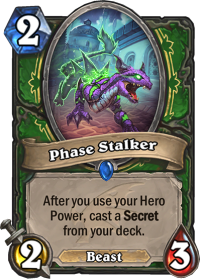When it comes to building a successful deck in Hearthstone, there’s a rule you should understand: redundancy is power.
That is to say by increasing the number of similar effects within a deck, you can reach a state where the whole is greater than the sum of its individual parts. Put enough bad cards together and they can – in some cases – become a good deck, provided they all aim at the same goal.
Galakrond and Invoke
First, I want to consider one of the simplest examples of how power can be found in redundant effects: Galakrond and Invoke cards. Playing invoke cards makes Galakrond better, and the more of them you play (up to 4), the better Galakrond gets. These invoke cards also make the synergy cards – like Scion of Ruin – better (up to 2).

Invokes make Galakrond better. They also make the synergy cards better. Because Galakrond is more powerful, Kronx Dragonhoof gets better. As all these cards make each other better and there are a limited number of them, the correct choice is often to just play all of them in the same deck (playing Umbral Skulker and Priest in general might be the exceptions). Altogether you have a package of 10-12 cards which you then build the rest of your deck around, using cards that synergize with what they offer.
In some cases, players find themselves disappointed with one or more of the invoke cards, as they deem them to be too slow, awkward, or unimpactful. Independently, they can indeed look pretty unassuming. However, the nature of invoke heavily discourages you from cutting them from your deck.
While it’s true enough that when you play an invoke card you do always get the benefit of a Galakrond hero power, their real power resides in hitting certain breakpoints: 2 and 4 total invokes. If you only invoke once, it’s like you didn’t invoke at all from the perspective of Galakrond and the synergy cards (including Kronx, if it draws Galakrond). On the other hand, invoking twice is the same as invoking three times from the perspective of Galakrond (and Kronx), while the difference between three and four is massive.
The power of these invoke cards, then, is found in their density within the deck. Ideally you would only want 4 in your deck to max out Galakrond, but because you also want to guarantee that you draw 4, this encourages you to play as many as you can as one or more might be buried in the bottom of your deck. By cutting the weakest of the invoke cards from your deck, you dramatically decrease the power of your Galakrond and Kronx, while also modestly decreasing the power of your synergy cards.

To put that into some concrete numbers, we could consider 2 versions of Galakrond Rogue: one that runs all the invoke cards and one that runs six of them, cutting the Devoted Maniacs for independently better cards (SN1P-SN4P and Zilliax).
Both decks have almost equal average win rates, but the win rate of Kronx and Galakrond (when drawn at any point in the game) vary significantly. The deck running all the invoke cards boasts a Galakrond drawn win rate of 62.7%, while the deck running only six invoke cards sees that drop by about 3%. The story is similar for Kronx, who suffers a roughly 2.5% drop in win rate. (Those numbers are accurate at the time of posting this, might be a bit different when you read it)
Now that is, to some degree, compensated by the gain in win rate of trading the Maniacs (the worst drawn win rate card in the deck) for Zilliax and Sn1p-Sn4p, but it demonstrates the point well: redundancy between effects that directly synergize with each other can transform bad cards into powerful effects. No one can deny that the two Mechs are stronger than Maniacs, and yet replacing them with a weaker card doesn’t negatively impact your win rate.
Face Hunter and Damage
Next, let’s consider a slightly trickier example: Face Hunter.
What’s interesting about this deck is precisely how many bad cards it runs. By “bad card” what I mean is that, in a vacuum, these cards are weak. They are not currently played in a variety of other decks and they have not been played in successful decks over time. Putting these cards into decks tends to reduce their win rate. That list of bad cards includes (but is not limited to) two copies of each of the following: Arcane Shot, Leper Gnome, Rapid Fire, and Kobold Sandtrooper. That’s nearly a third of the deck.

What makes those cards bad is that they tend to offer inefficient exchanges, whether in terms of mana (like how Rapid Fire offers 2 damage for 2 mana; a bad rate) or low value-per-card (like how Arcane Shot or Leper Gnome offer small amounts of damage at the cost of spending a full card for their effect). Deck utilizing these cards would tend to fall behind on tempo or run out of resources before they win in most cases.
Nevertheless, there’s something special that happens when all these bad cards are played in the same deck. While they have no obvious synergy like Galakrond cards do, they have an underlying, incredibly powerful synergy: they all reduce the opponent’s life total. As a win condition, this can be incredibly effective. The moment inflicted damage on the opponent’s face reaches 30 (assuming no healing), the opponent loses – it’s as simple as that. This makes the face/burn strategy a very all or nothing kind of synergy: if you don’t have enough burn it’s like you have none. An opponent is as alive at 1 health as they are at 30 health + 70 armor. However, the moment you assemble the right amount or above, you win.
This makes face damage synergize well with lots of other face damage, even if that damage isn’t particularly efficient. In essence, every card that deals face damage (even the bad ones) makes every other card that deals face damage better, provided there’s enough of it. The synergy is implicit, but it’s there.

A quick example of how this gets applied in the deckbuilding portion of Face Hunter concerns the Secret package they run, which is often just 2 copies of Explosive Trap and 2 copies of Phase Stalker. While you might be tempted to play more Secrets to get better value off Phase Stalker, this can be a mistake because each time Phase Stalker fails to pull a secret that does face damage, you have made every face damage card in your deck worse. Better to aim for consistency. It’s no surprise that Face Hunters playing Freezing Trap find that to be – by far – the worst performing card in the list. This is because when you get the Freezing Trap, you are literally making every other card in your deck worse (because you might not reach the critical mass of burn damage to kill the opponent).
Now, as I said, these face cards are bad independently. This is proven by the fact that it’s exceptionally easy to run a Face Hunter deck out of gas with even a minimal amount of healing. Their resources are limited and low in tempo, so it’s easy to push them off the board and out-heal their burst damage. Accordingly, Face Hunter can never truly be a good deck because the moment it becomes popular, anyone who is trying to can completely smash them into little bitty Hunter pieces. Currently Warrior and Priest are well suited to completing the task, but any class could, in theory, build a deck that beats them easily.
Questions to Think About
When you’re building your own decks or tinkering with other lists, you can use this principle of powerful redundancy to think about possible changes
- How good are these cards on their own? Zilliax doesn’t need support to make it a good card, while Leper Gnome does.
- Is there enough synergy to make your deck go? In the effort to cut down on independently bad cards, bear in mind you might be making large portions of your deck worse.
- Does the synergy between the bad cards make something greater than the sum of their parts? Playing all the invoke cards might give Galakrond enough of a boost that you more than offset the downsides of playing some independently-weak options.
- Have you hit diminishing returns yet? Face Hunter seems to want all sorts of damage cards, but the C’thun decks of past metagames didn’t play every single C’thun buffer because at some point they stopped making the deck better.

Great article!
Good article JAlex. 🙂 I really like this content, thanks!
Im surprised that quest resurrect priest didnt make it to this list since running 2 copies of sandhoofs makes face hunter become concede hunter